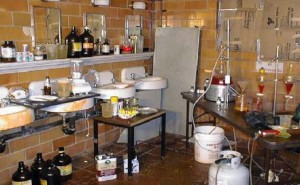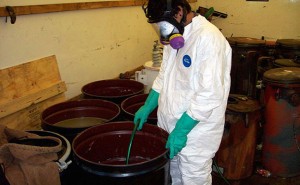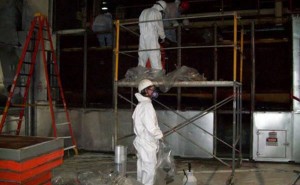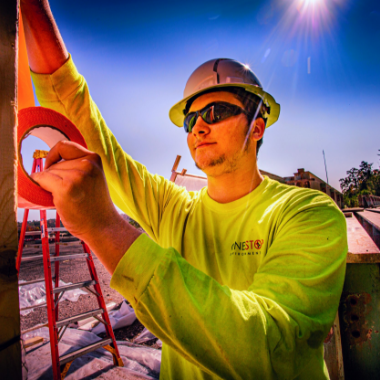Whether it’s a college chemistry lab, a break-bulk terminal accumulating damaged packages, or a maintenance department storing old and discarded materials, it’s common to find identification markings no longer readable, or even present.
In order to safely and properly dispose long-unused materials, you must first identify what the materials are, and what hazards they present. Through field or laboratory analysis, our hazardous materials professionals and staff chemist can identify and characterize unknown substances. Then we’ll ensure your materials are properly disposed.
When small containers are involved, we’ll consolidate waste materials by hazard classification, then prepare Lab Packs for disposal.
 Meth lab cleanup presents a unique emergency response situation. The criminals who run labs typically handle extremely toxic chemicals with little regard for contamination.
Meth lab cleanup presents a unique emergency response situation. The criminals who run labs typically handle extremely toxic chemicals with little regard for contamination.
We’ve been cleaning-up drug labs for the DEA, local law enforcement, insurance companies, property owners and realtors since early 2006. Our trained technicians have conducted safe meth lab cleanups at more than 5000 sites in Alabama alone.
We start with a thorough site assessment.
We’ll determine the steps needed to make the area safe, and generally have all of the lab materials removed for disposal in an hour or less.
Next, one of our strategic partners will conduct a wipe test — sending samples to a certified EPA accredited lab for analysis — which will tell us the contamination level that exists after the major hazards have been removed.
Those test results, plus information from our technicians’ onsite inspection, are used to determine pricing for total decontamination.
When decontamination is complete, we’ll conduct another wipe test — ensuring hazards are no longer present. Finally, we’ll produce a thorough report of our process and the results.
Ambipar Response OSE’s cleanup technicians are trained in the following areas:
- OSHA 40 HR Hazwoper
- DOT HazMat
- With additional safety training for trailer use
- Blood Borne Pathogen
- First Aid / CPR
- DEA-specific adulteration procedures
- DEA Contractor Personnel Reporting Requirements
- DEA “Red Book”.
We maintain the following spill programs:
- Spill Prevention and Response
- Spill Incident Training
- Spill Management
- General Laboratory Safety.
In short, our experience has prepared our team to handle any type of spill that may occur, or has occurred at a lab prior to our arrival.
Proper disposal is crucial in meth lab cleanup.
Ambipar Response OSE upholds all federal, state and local regulations. Before we arrange pickup, we’ll complete all waste manifest and profiles, then ensure that disposal is approved at the facility,
We’ll correctly package all waste for transport before loading it. And we’ll provide you with all manifests, bills of lading and certificates of disposal for you records.
Meth Lab Cleanup to Support the Drug Enforcement Agency
Since 2012, our program has used container pick up, and we’ve worked with every container site in Alabama.
On site, we take responsibility for verifying all materials are properly packaged for transport — re-packaging whatever needs it, verifying that all chain-of-custody documents are correctly filled, properly completing all manifest paperwork, loading trucks and transporting all materials back to our secure holding area. Then we’ll arrange for final disposal.
Our leadership in the container-pickup program
When our contract was changed from onsite cleanup effort to the container program, our supervisor played a key role in assisting local law enforcement with the transition — working with the DEA, and their training teams, to educate field personnel on how to properly identify, segregate and package materials found at active labs.
He’s also served as an ongoing educational resource — answering numerous questions about the paperwork required in cleanup and disposal efforts.
Dangers associated with meth labs
Meth labs are operated in apartments, houses, hotel rooms, mobile homes, storage facilities and even vehicles. Producing methamphetamine involves a variety of chemicals, including solvents, metals, salts, corrosives and explosives. Hazardous and flammable chemicals can be spilled, or emitted to the air, during production — posing the additional risk of fire and explosions.
Even short-term exposure to the chemical vapors in a meth lab can cause severe health problems (including shortness of breath, coughing, chest pains, dizziness, lack of coordination, chemical irritation and burns to the skin, eyes, mouth and nose) — even death.
Corrosive substances can cause injury if inhaled or touched. Solvents can irritate the skin, mucous membranes and respiratory tract — and can cause central nervous system effects. Because they are flammable, they also pose a risk for severe burns.
Other chemicals can cause cancer and damage to the brain, liver and kidneys — as well as birth defects and reproductive problems.
“Cooking” releases large amounts of methamphetamine into the air, which settles on most items and surfaces throughout the building. Liquid waste from the manufacturing process is often spilled — affecting floors and walls — and dumped into drains, contaminating wells and septic tanks. Finally, airborne contaminants can enter and contaminate heating and cooling systems.
 All hazardous wastes must be segregated to prevent incompatible mixtures that multiply adverse effects. Our technicians are trained on to segregate lab waste by hazard classes — ensuring that everything is disposed of safely.
All hazardous wastes must be segregated to prevent incompatible mixtures that multiply adverse effects. Our technicians are trained on to segregate lab waste by hazard classes — ensuring that everything is disposed of safely.
Examples of proper segregation:
- Segregating oxidizers from organics
- Segregating acids from bases
- Segregating cyanides from acids.
The primary challenge most of our clients face with abandoned lab chemicals is that most are not clearly labeled. Our technicians can correctly identify chemicals, through field or laboratory analysis — ensuring that they’re segregated correctly.
What is Hazardous Waste Consolidation?
It’s combining hazardous waste streams into larger containers for storage and transportation — saving you money on transport and disposal while reducing their environmental impact.
As a full service environmental cleanup company, Ambipar Response OSE can seamlessly segregate, consolidate, package, transport and dispose of your chemical waste.
 Our hazardous materials professionals and staff chemists are experienced in conducting laboratory and factory closures.
Our hazardous materials professionals and staff chemists are experienced in conducting laboratory and factory closures.
Because our clients’ liability exposure for hazardous waste extends long after closures are complete, we meticulously manage every aspect of the waste removal process.
We’ll focus on your facility closure so you can focus on running your business.
We’ll identify what materials are present and the hazards they pose. We’ll consolidate your waste, prepare lab packs for disposal, and transport them to appropriate waste facilities.
Some of our facility closure projects include:
- Chicago Bridge, Tarrant, AL
- Big Springs Bottling Company, Huntsville, AL
- Chemistry Lab- Cornerstone Schools of Alabama, Birmingham, AL
Contact us today for a free quote for your specific need.




